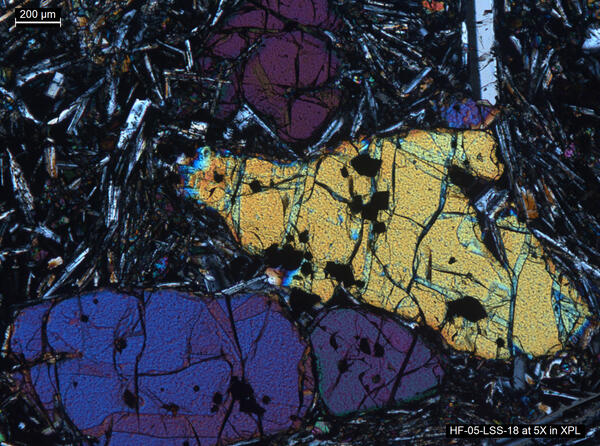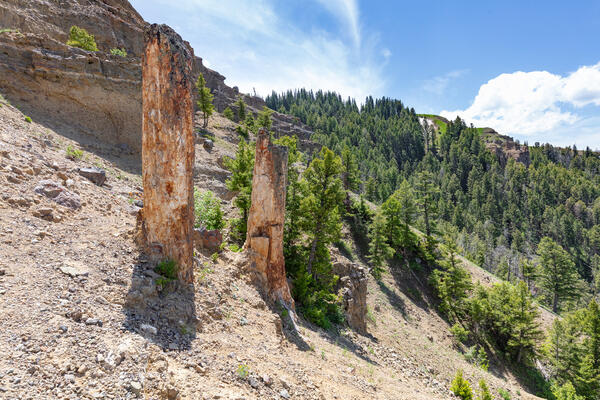An example of a boundary iproblem n the Yellowstone National Park geologic map, which was stitched together from many smaller mapped sections. The red line highlights the contacts that contain different units across the boundary.
Images
Images related to Yellowstone Volcano Observatory.

An example of a boundary iproblem n the Yellowstone National Park geologic map, which was stitched together from many smaller mapped sections. The red line highlights the contacts that contain different units across the boundary.

A scanned image of Rocky Mountain juniper deadwood sample GGR100 collected in the northern part of Yellowstone National Park under permit YELL-5582. The full length of this sample covers the time period 723-1792 CE.
A scanned image of Rocky Mountain juniper deadwood sample GGR100 collected in the northern part of Yellowstone National Park under permit YELL-5582. The full length of this sample covers the time period 723-1792 CE.

Cross section through the Earth showing the ground surface with an embedded pressure source (red circle)—the so-called “Mogi model”—beneath the ground. When this pressure source expands, the ground surface inflates like a balloon (the opposite occurs when the pressure in the source decreases). Dashed black line shows, in an exaggerated way, how the shape
Cross section through the Earth showing the ground surface with an embedded pressure source (red circle)—the so-called “Mogi model”—beneath the ground. When this pressure source expands, the ground surface inflates like a balloon (the opposite occurs when the pressure in the source decreases). Dashed black line shows, in an exaggerated way, how the shape

Photo looking north from the north shore of Yellowstone Lake. The photo was taken from a level bench, or terrace, which marks a previous high stand of the lake. In the middle distance (between the two red lines), the ground slopes up to second, higher-level terrace that indicates an even higher past lake level.
Photo looking north from the north shore of Yellowstone Lake. The photo was taken from a level bench, or terrace, which marks a previous high stand of the lake. In the middle distance (between the two red lines), the ground slopes up to second, higher-level terrace that indicates an even higher past lake level.

USGS scientist Laura Clor performing maintenance on the SNIF multi-GAS station on Mount St. Helens, Washington.
USGS scientist Laura Clor performing maintenance on the SNIF multi-GAS station on Mount St. Helens, Washington.

Interior of the SNIF multi-GAS enclosure on Mount St. Helens, Washington
Interior of the SNIF multi-GAS enclosure on Mount St. Helens, Washington

Thin section image of a lava sample from Yellowstone using a polarizing microscope. The mineral assemblage is representative of many of Yellowstone’s basaltic rocks. The three large and colored crystals (known as phenocrysts) in the center of the image are the mineral olivine.
Thin section image of a lava sample from Yellowstone using a polarizing microscope. The mineral assemblage is representative of many of Yellowstone’s basaltic rocks. The three large and colored crystals (known as phenocrysts) in the center of the image are the mineral olivine.

In the first few minutes of Steamboat's eruptions, it has often been measured well over 300 ft. with a few exceptional eruptions measured by visitors at over 400 ft.! In this example, done using a rangefinder by a Yellowstone National Park ranger, it comes in at 334.9 ft. For comparison, the Lower Falls of the Yellowstone is about 308 ft.
In the first few minutes of Steamboat's eruptions, it has often been measured well over 300 ft. with a few exceptional eruptions measured by visitors at over 400 ft.! In this example, done using a rangefinder by a Yellowstone National Park ranger, it comes in at 334.9 ft. For comparison, the Lower Falls of the Yellowstone is about 308 ft.

National Park Service scientist using a camera paired with a GPS receiver to obtain images of Castle Geyser, Yellowstone National Park, in June 2019.
National Park Service scientist using a camera paired with a GPS receiver to obtain images of Castle Geyser, Yellowstone National Park, in June 2019.
Sapphire Pool, in Biscuit Basin, steams on a stormy morning. A few “biscuits” remain along the pool’s southern edge (center right of photo) – violent geyser eruptions destroyed hundreds of the features when the pool’s plumbing system changed after being jarred by the 1959 Hebgen Lake earthquake. National Park Service photo by Jacob W. Frank, July 20, 2020.
Sapphire Pool, in Biscuit Basin, steams on a stormy morning. A few “biscuits” remain along the pool’s southern edge (center right of photo) – violent geyser eruptions destroyed hundreds of the features when the pool’s plumbing system changed after being jarred by the 1959 Hebgen Lake earthquake. National Park Service photo by Jacob W. Frank, July 20, 2020.

Comet NEOWISE is seen with the Roosevelt Arch in the foreground at the north Entrance of Yellowstone National Park. The town of Gardiner, Montana, is in the background.
Comet NEOWISE is seen with the Roosevelt Arch in the foreground at the north Entrance of Yellowstone National Park. The town of Gardiner, Montana, is in the background.

Panoramic photo of Hayden Valley looking east toward the Yellowstone River from the Mary Mountain trail.
Panoramic photo of Hayden Valley looking east toward the Yellowstone River from the Mary Mountain trail.

A small stream, Violet Creek, winds its way through Hayden Valley in Yellowstone National Park.
A small stream, Violet Creek, winds its way through Hayden Valley in Yellowstone National Park.

Comparison of photos from Giant and Castle Geysers separated by almost 150 years. These images suggest almost no changes to the geyser structure implying that large geysers form over thousands of years.
Comparison of photos from Giant and Castle Geysers separated by almost 150 years. These images suggest almost no changes to the geyser structure implying that large geysers form over thousands of years.

Photo of volcaniclastic units of the Absaroka volcanic province in northeastern Yellowstone National Park
linkPhoto of geologic units of the Absaroka volcanic province in northeastern Yellowstone National Park that shows volcaniclastic sandstones grading up into a conglomerate, followed by another sequence of sandstone to conglomerate. These repeating layers of the same-looking material make it difficult to assign them to a specific volcanic group.
Photo of volcaniclastic units of the Absaroka volcanic province in northeastern Yellowstone National Park
linkPhoto of geologic units of the Absaroka volcanic province in northeastern Yellowstone National Park that shows volcaniclastic sandstones grading up into a conglomerate, followed by another sequence of sandstone to conglomerate. These repeating layers of the same-looking material make it difficult to assign them to a specific volcanic group.

A view into the Absaroka Mountains in northeastern Yellowstone National Park. While the Absarokas of today look a little different due to glacial activity, these are the same mountains that existed over the last 53 million years, well before the arrival of the Yellowstone hot spot.
A view into the Absaroka Mountains in northeastern Yellowstone National Park. While the Absarokas of today look a little different due to glacial activity, these are the same mountains that existed over the last 53 million years, well before the arrival of the Yellowstone hot spot.

Geologists from Montana State University study an outcrop of diorite (a silicic igneous rock that cooled slowly beneath the ground). An outcrop of this size is important because it is easier to see any structural relations along with rock composition.
Geologists from Montana State University study an outcrop of diorite (a silicic igneous rock that cooled slowly beneath the ground). An outcrop of this size is important because it is easier to see any structural relations along with rock composition.

Newly identified ash flow sheets within the Yellowstone–Snake River Plain volcanic province (Y-SRP). The small inset in the center shows the track of the Yellowstone hotspot and its associated eruptive centers in light gray (M—McDermitt; OH—Owyhee-Humboldt; BJ—Bruneau-Jarbidge; TF—Twin Falls; P—Picabo; H—Heise; Y—Yellowstone).
Newly identified ash flow sheets within the Yellowstone–Snake River Plain volcanic province (Y-SRP). The small inset in the center shows the track of the Yellowstone hotspot and its associated eruptive centers in light gray (M—McDermitt; OH—Owyhee-Humboldt; BJ—Bruneau-Jarbidge; TF—Twin Falls; P—Picabo; H—Heise; Y—Yellowstone).

Petrified trees on Specimen Ridge, Yellowstone National Park. NPS photo by Jake Frank, June 13, 2020.
Petrified trees on Specimen Ridge, Yellowstone National Park. NPS photo by Jake Frank, June 13, 2020.

Standing petrified (silicified) trees on Specimen Ridge in northeastern Yellowstone National Park.
linkTwo standing petrified (silicified) trees on Specimen Ridge in northeastern Yellowstone National Park. Photo by Jacob W. Frank, Yellowstone National Park (https://www.flickr.com/photos/yellowstonenps/50016729252).
Standing petrified (silicified) trees on Specimen Ridge in northeastern Yellowstone National Park.
linkTwo standing petrified (silicified) trees on Specimen Ridge in northeastern Yellowstone National Park. Photo by Jacob W. Frank, Yellowstone National Park (https://www.flickr.com/photos/yellowstonenps/50016729252).

Simplified Geologic Map of Yellowstone, modified from USGS I-711 by Marli Miller, University of Oregon. All rock material resulting from the major caldera-forming eruptions are labelled at Qt, where the dashed caldera boundary highlights the scale of these events. Older volcanic, sedimentary and metamorphic rocks are found outside of this boundary.
Simplified Geologic Map of Yellowstone, modified from USGS I-711 by Marli Miller, University of Oregon. All rock material resulting from the major caldera-forming eruptions are labelled at Qt, where the dashed caldera boundary highlights the scale of these events. Older volcanic, sedimentary and metamorphic rocks are found outside of this boundary.


